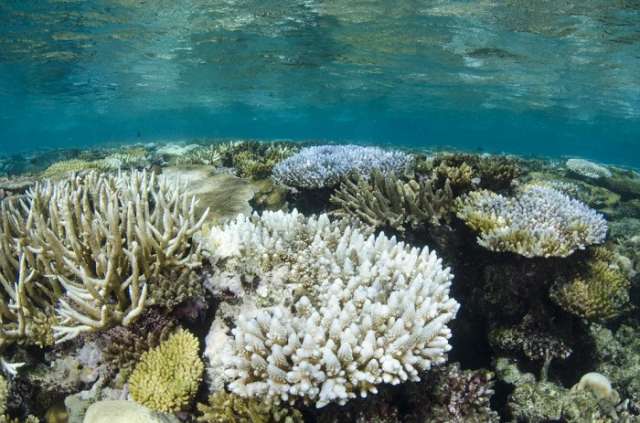"In shallow water, above 15 metres and in places down to 20 metres, we've seen a lot of coral mortality - probably somewhere in the region of 90 percent," said John Turner, a professor at Bangor University in Wales, who led the recent expedition. "
It's a very upsetting thing to see, when these reefs have developed so well, and to see them being essentially reset, if you'd like."
The reef is believed to have suffered back-to-back bleaching events in 2015 and 2016, Turner told The Washington Post. These events were brought on by unusually warm conditions, likely influenced by climate change and an unusually severe El Niño effect in 2015.
Scientists have found that coral reefs all over the world have been affected by these conditions, though not all have fared as badly as those in the Chagos area or the Great Barrier Reef.
Bleaching doesn't automatically mean death for coral reefs. It's a natural reaction to environmental stress, such as high temperatures, that causes the corals to expel the tiny algae that live inside them and give them their brilliant colours.
Given enough time, the coral will regrow its algae and return to normal. But bleaching events can weaken the reefs, making them more vulnerable to disease. And if stressful conditions last long enough, the coral may begin to die.
Before the more recent bleaching event in the Chagos Archipelago, an El Niño effect in 1997 and 1998 caused a severe one. It took until about 2012 before the Chagos reef appeared to have recovered.
Now, Turner says, the Chagos area has suffered so much coral death that "the reefs have basically been set back to the '97-'98 cover levels of coral."
This raises alarm about the archipelago's future, especially amid concerns about rising global sea levels. "If the reefs begin to die off in any way or erode, then of course these atolls are at risk," Turner said.
"Erosion will begin to exceed growth, and we will see these islands begin to recede... That's the natural way with atolls."
The Chagos Archipelago includes a collection of coral atolls. One of them, the Great Chagos Bank, is the largest coral atoll in the world.
It sits in the middle of the Indian Ocean, midway between the eastern coast of Africa and Singapore and about 300 miles (483 km) south of the Maldives, the closest island nation.
The archipelago's original inhabitants were expelled in the 1960s and moved to Mauritius and the Seychelles to make way for military bases, and there's an ongoing sovereignty dispute over the islands between Mauritius and the United Kingdom.
Only one island in the archipelago - Diego Garcia, the largest - is inhabited by humans, mostly military personnel and contractors.
Until recently, the area around the Chagos Archipelago was the largest marine protected area in the world. (It has since lost the title to other marine reserves designated in the past few years).
Because of its protected status, Turner said, "one would hope these reefs were pristine."
In fact, he said, a major part of the archipelago's scientific significance is the fact that most of the islands are nearly untouched by human influence.
That makes the site something of a reference point for researchers - a place where the ongoing effects of processes like climate change might be observed without all the extra noise that comes with human activities like fishing or construction.
"But actually, what we have learned is that the big bleaching events that are caused by ocean warming have affected these reefs just like any other," Turner said.
Coral sampling during the expedition showed that about 90 percent of all the coral in the archipelago's shallow waters - at depths above 50 feet (15 m) or so - have died. In deeper waters, most of the corals are surviving, although there's widespread evidence of bleaching, researchers said.
Turner remains optimistic about the reef's ability to bounce back.
"We're seeing lots of juvenile corals beginning to grow on these reefs," he said. "So that's a good sign."
Still, one point of concern is that many of these young corals are settling down on the frames of dead corals, which may eventually break down, Turner said. In the longer term, more bleaching events in the coming years could further devastate an already weakened reef.
As climate change is expected to cause severe warming events to become more frequent in the future, scientists are beginning to worry that many reefs around the world won't have adequate time to bounce back between bleaching events.
This is one of the issues facing the Great Barrier Reef.
Turner noted, however, that because the Chagos Archipelago is so remote and has enjoyed protection over the years, it has been spared some of the other damaging effects of human influence - such as overfishing or damage from boats and divers - that have plagued other reefs, including the Great Barrier Reef.
As a result, he said, there's hope that the coral there may be hardier than in other places.
"We do make the point that this is resilient and there is a good possibility of recovery," he said.
/Science Alert/
More about: #GlobalWarming
















































